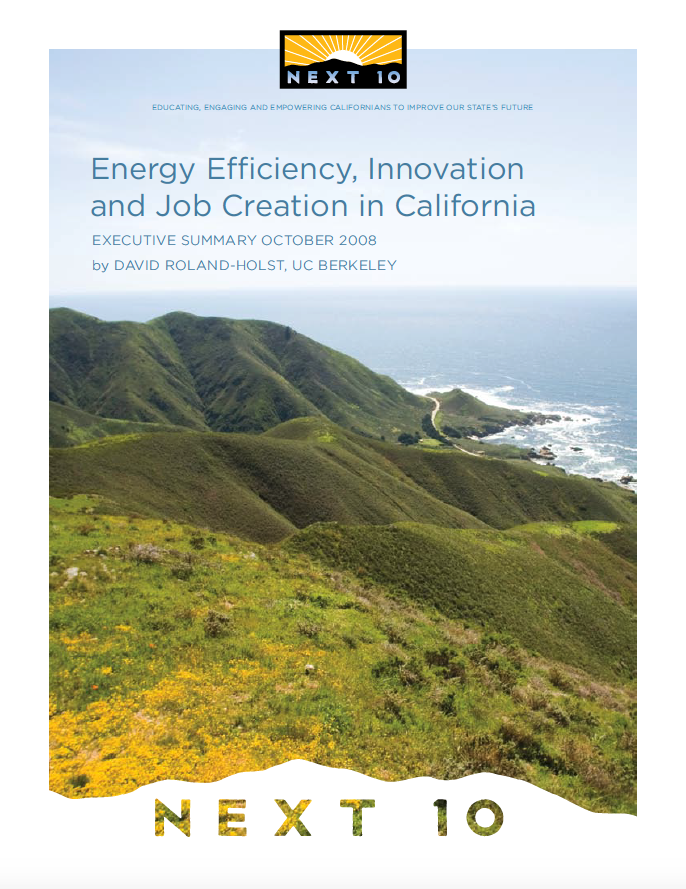Publications
Energy Efficiency, Innovation and Job Creation in California
Global climate change poses significant risks to the California economy. Recognizing and responding to these threats, Governor Schwarzenegger signed Executive Order #S-3-05 which called for a 30 percent reduction below business-as-usual of greenhouse gas emissions by 2020 and 80 percent below 1990 levels by 2050.
In September 2006, the California legislature passed and Governor Schwarzenegger signed AB 32 into law, which mandates a first-in-the-nation limit on emissions that cause global warming. In June 2006, the California Air Resources Board (CARB) released a "Draft Scoping Plan" – the policy roadmap to meet the emissions reduction target of 169 million metric tons of carbon dioxide equivalent (MMTCO2e) by 2020 to stabilize at 427 MMTCO2e overall. The CARB board will take up final adoption of this plan in December 2008.
During the months leading up to this decision, a financial crisis of global proportions is unfolding. The state, nation and world are caught in serial market failures sparked by the collapse of the housing industry, and there is much speculation about the impact of declining capital gains revenue on the state budget.
Against this backdrop, Energy Efficiency, Innovation, and Job Creation in California analyses the economic impact of CARB’s past and future policies to reduce fossil fuel generated energy demand. California’s achievements in energy efficiency over the last generation are well known, but evidence about their deeper economic implications remains weak. This study examines the economy-wide employment effects of the state’s landmark efficiency policies over the last 35 years, and finds that innovative energy efficiency policies created 1.5 million additional full-time jobs with total payroll of over $45 billion.
Next 10 does not own the rights to this publication. The author(s) of the report must be contacted regarding any usage of content from this publication.
The report's historical findings include:
- Without taking the aggressive steps to reduce energy dependence and increase energy productivity over three decades ago, California would be more vulnerable to the current economic crisis—with greater dependence on volatile fossil fuel prices, lower consumer savings, and, as a result, reduced spending.
- Over the past 35 years, forward-looking energy efficiency policies created 1.5 million full-time equivalent (FTE) jobs with a total payroll of over $45 billion, and saved California consumers over $56 billion on energy costs.
- The same efficiency measures resulted in slower (but still positive) growth in energy supply chains, including oil, gas, and electric power. For every new job foregone in these sectors, however, more than 50 new jobs have been created across the state's diverse economy.
- Sectoral examination of these results indicates that job creation is in less energy intensive services and other categories, further compounding California’s aggregate efficiency improvements and facilitating the economy’s transition to a low carbon future.
The report's other findings include:
- By taking account of the potential for innovation, the proposed package of policies in the state’s Draft Scoping Plan continues California’s legacy of efficiency-driven job growth, achieving 100 percent of the greenhouse gas emissions reduction targets mandated by AB 32 while increasing the Gross State Product (GSP) by about $76 billion, increasing real household incomes by up to $48 billion and creating as many as 403,000 new efficiency and climate action driven jobs.
- The economic benefits of energy efficiency innovation have a compounding effect. The first 1.4 percent of annual efficiency gains produced about 181,000 additional jobs, while an additional one percent yielded 222,000 more. It is reasonable to assume that incremental efficiency gains will be more costly, but they have more intensive economic growth benefits.
- Existing energy efficiency programs and proposed state climate policies will continue the structural shift in California's economy from carbon-intensive industries to more job-intensive industries.
- While employment continues to grow in the carbon fuel supply chain, it is slower than it would be without implementation of these policies. Thus, there are no real job losses in these sectors, but many new opportunities arise elsewhere.
- The size and distribution of potential growth benefits that result from the increase of merely one percent in energy efficiency justify significant commitments to explicit incentives for competitive innovation and investment in the discovery and adoption of new efficiency technologies. These technologies offer win-win solutions to the challenge posed by climate change for the state's industries and consumers.
- Clearly establishing a price for carbon emissions provides economic stimulus for efficiency innovation. To accelerate that innovation, revenues raise from the cap-and-trade system can be at least partly invested in R&D and adoption incentives for these technologies.
- By revenue, energy is the world’s largest industry, and energy efficiency can become to this sector what IT was to management, biotech to medicine, a way to revolutionize traditional practices and increase real living standards around the world.
- California can sustain its enormous economic potential and establish global leadership in the world's most promising new technology categories, energy efficiency, just as it did so successfully in IT and biotechnology. This will secure the state's transition to a low-carbon future and establish competitive leadership in another breakout technology industry.
